Report: Accounting Theory and Practice - Fair Value Analysis
VerifiedAdded on 2021/09/23
|9
|2232
|83
Report
AI Summary
This report provides a comprehensive analysis of fair value accounting, exploring its definition, advantages, and disadvantages. It examines the concept's role in financial reporting, contrasting it with historical cost accounting and highlighting the importance of accurate valuation and timely information. The report delves into the three-tier process involved in fair value estimation, emphasizing the primacy of market-based measures and the use of valuation models. Furthermore, it discusses the qualitative characteristics of financial information relevant to fair value methods, such as relevance, faithful representation, understandability, comparability, and timeliness. The report also addresses the practical application of fair value measurement to asset elements and potential challenges, including price manipulation and downward valuations. The report concludes by referencing key literature on the topic.
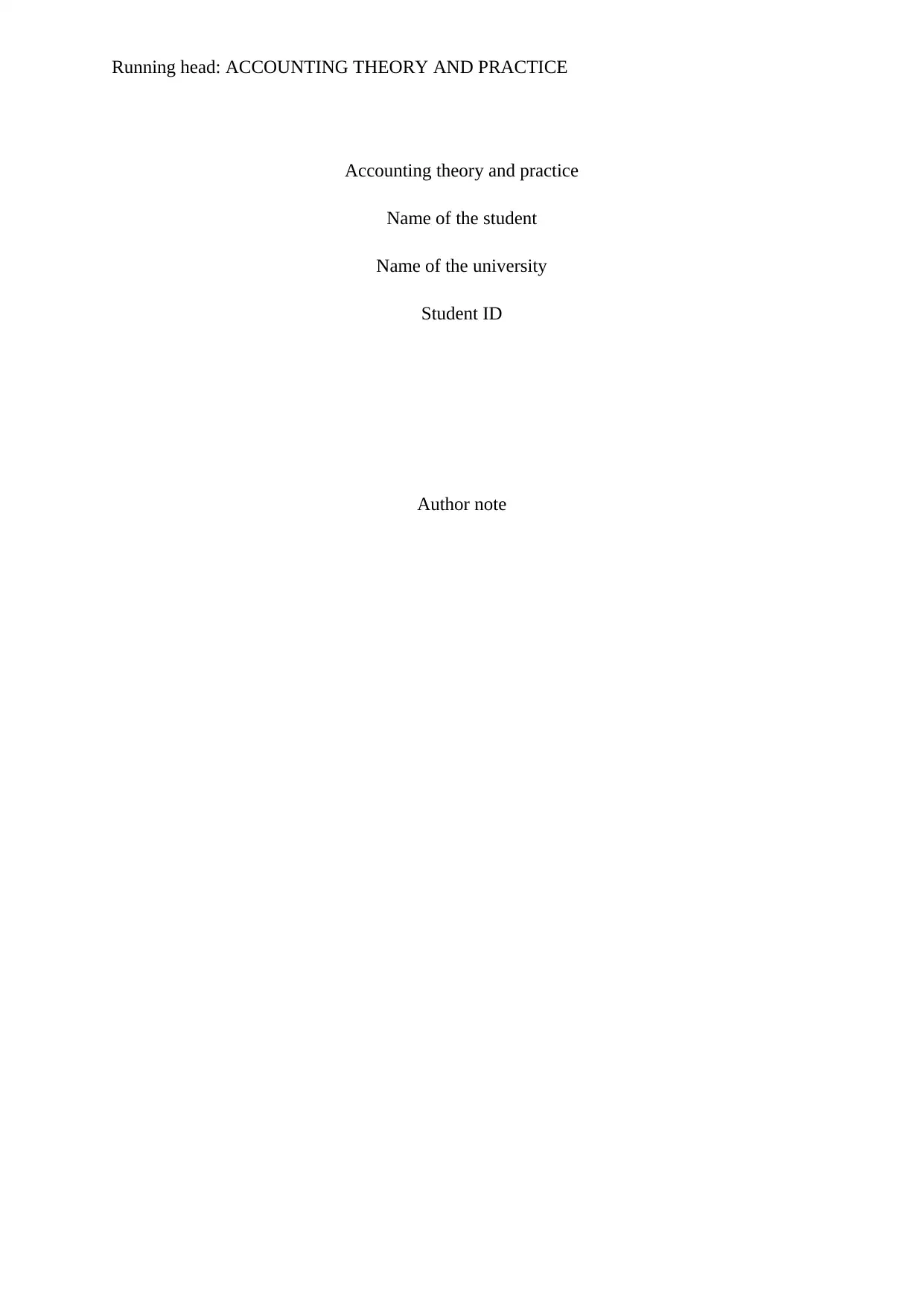
Running head: ACCOUNTING THEORY AND PRACTICE
Accounting theory and practice
Name of the student
Name of the university
Student ID
Author note
Accounting theory and practice
Name of the student
Name of the university
Student ID
Author note
Paraphrase This Document
Need a fresh take? Get an instant paraphrase of this document with our AI Paraphraser
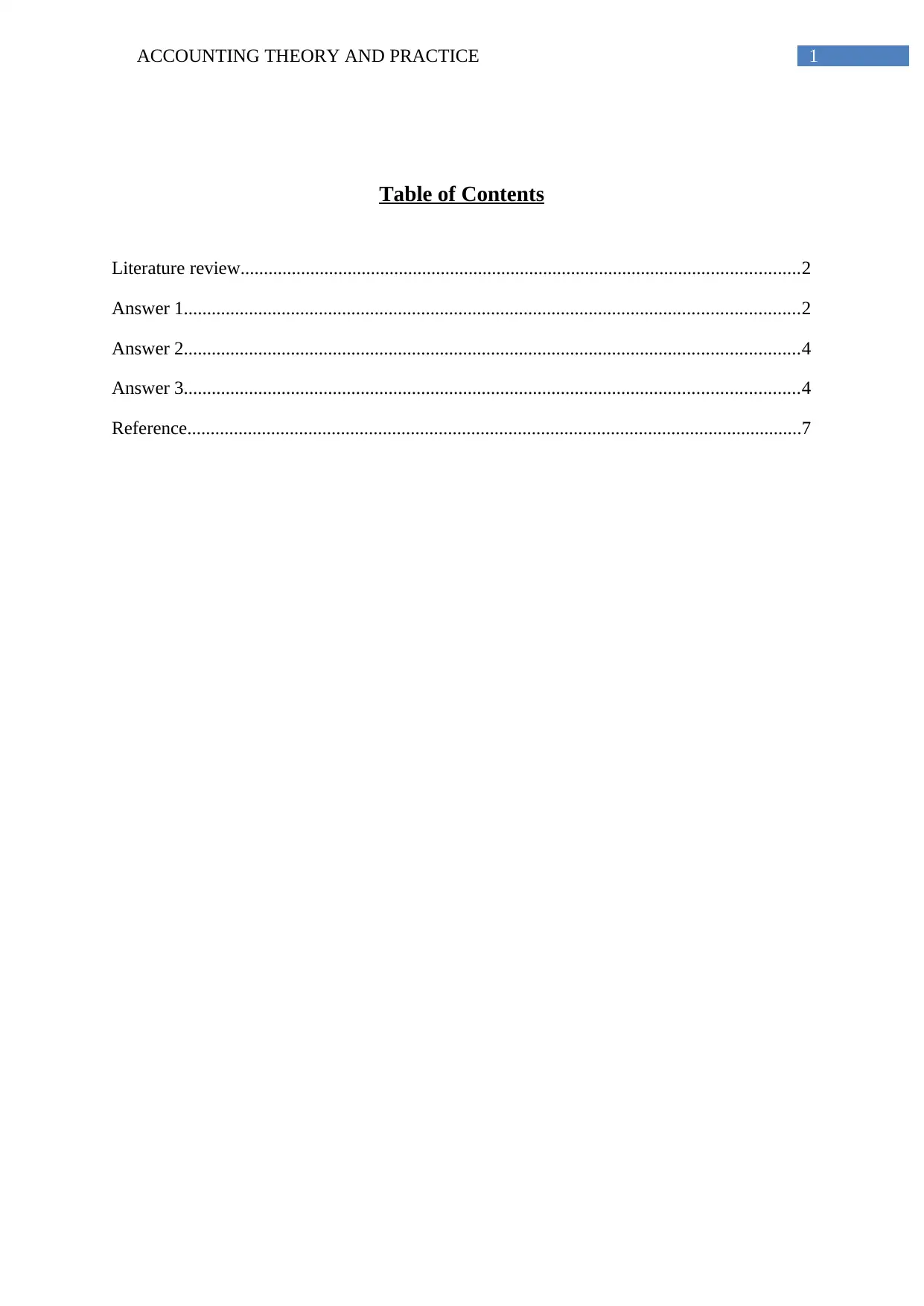
1ACCOUNTING THEORY AND PRACTICE
Table of Contents
Literature review........................................................................................................................2
Answer 1....................................................................................................................................2
Answer 2....................................................................................................................................4
Answer 3....................................................................................................................................4
Reference....................................................................................................................................7
Table of Contents
Literature review........................................................................................................................2
Answer 1....................................................................................................................................2
Answer 2....................................................................................................................................4
Answer 3....................................................................................................................................4
Reference....................................................................................................................................7
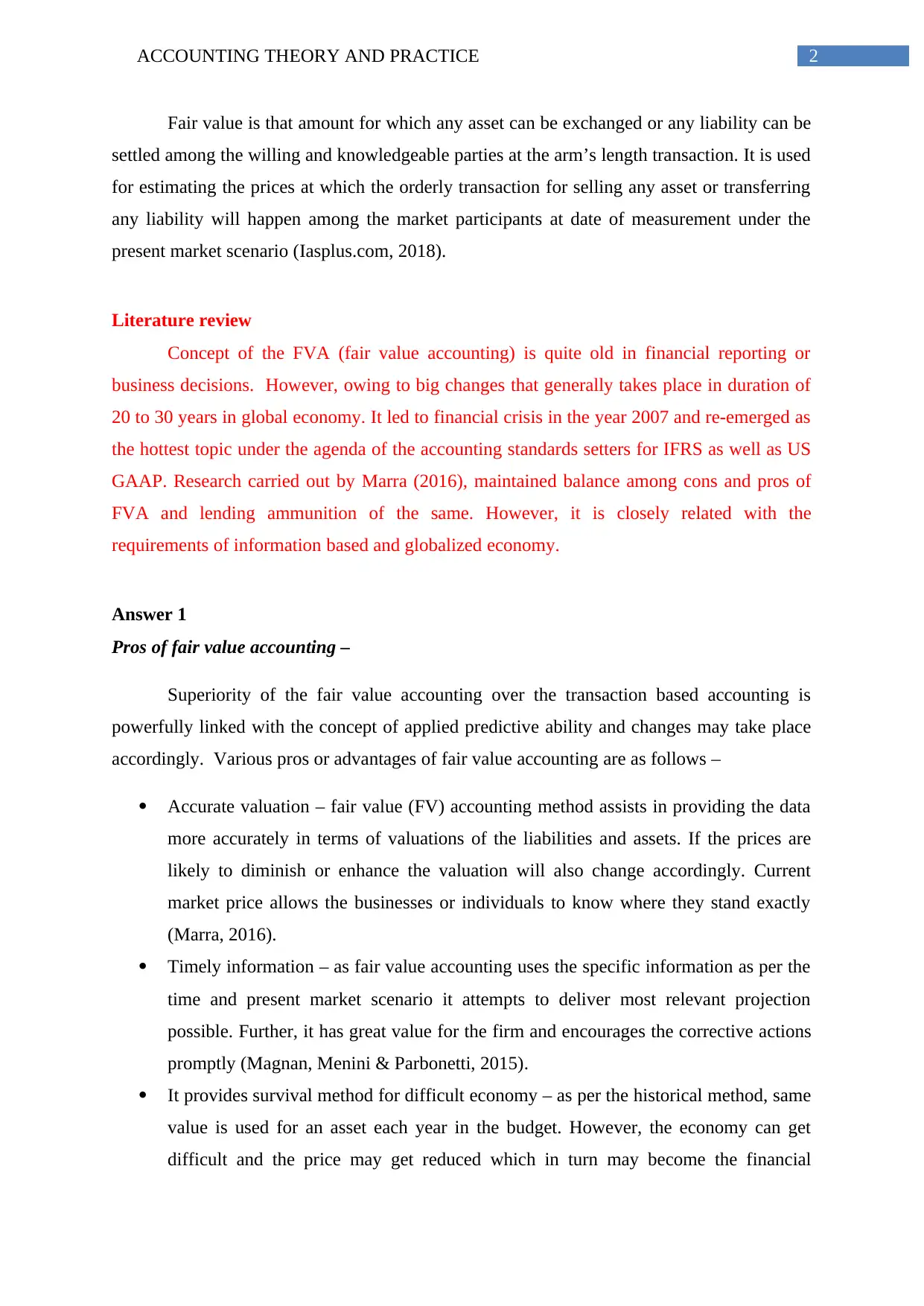
2ACCOUNTING THEORY AND PRACTICE
Fair value is that amount for which any asset can be exchanged or any liability can be
settled among the willing and knowledgeable parties at the arm’s length transaction. It is used
for estimating the prices at which the orderly transaction for selling any asset or transferring
any liability will happen among the market participants at date of measurement under the
present market scenario (Iasplus.com, 2018).
Literature review
Concept of the FVA (fair value accounting) is quite old in financial reporting or
business decisions. However, owing to big changes that generally takes place in duration of
20 to 30 years in global economy. It led to financial crisis in the year 2007 and re-emerged as
the hottest topic under the agenda of the accounting standards setters for IFRS as well as US
GAAP. Research carried out by Marra (2016), maintained balance among cons and pros of
FVA and lending ammunition of the same. However, it is closely related with the
requirements of information based and globalized economy.
Answer 1
Pros of fair value accounting –
Superiority of the fair value accounting over the transaction based accounting is
powerfully linked with the concept of applied predictive ability and changes may take place
accordingly. Various pros or advantages of fair value accounting are as follows –
Accurate valuation – fair value (FV) accounting method assists in providing the data
more accurately in terms of valuations of the liabilities and assets. If the prices are
likely to diminish or enhance the valuation will also change accordingly. Current
market price allows the businesses or individuals to know where they stand exactly
(Marra, 2016).
Timely information – as fair value accounting uses the specific information as per the
time and present market scenario it attempts to deliver most relevant projection
possible. Further, it has great value for the firm and encourages the corrective actions
promptly (Magnan, Menini & Parbonetti, 2015).
It provides survival method for difficult economy – as per the historical method, same
value is used for an asset each year in the budget. However, the economy can get
difficult and the price may get reduced which in turn may become the financial
Fair value is that amount for which any asset can be exchanged or any liability can be
settled among the willing and knowledgeable parties at the arm’s length transaction. It is used
for estimating the prices at which the orderly transaction for selling any asset or transferring
any liability will happen among the market participants at date of measurement under the
present market scenario (Iasplus.com, 2018).
Literature review
Concept of the FVA (fair value accounting) is quite old in financial reporting or
business decisions. However, owing to big changes that generally takes place in duration of
20 to 30 years in global economy. It led to financial crisis in the year 2007 and re-emerged as
the hottest topic under the agenda of the accounting standards setters for IFRS as well as US
GAAP. Research carried out by Marra (2016), maintained balance among cons and pros of
FVA and lending ammunition of the same. However, it is closely related with the
requirements of information based and globalized economy.
Answer 1
Pros of fair value accounting –
Superiority of the fair value accounting over the transaction based accounting is
powerfully linked with the concept of applied predictive ability and changes may take place
accordingly. Various pros or advantages of fair value accounting are as follows –
Accurate valuation – fair value (FV) accounting method assists in providing the data
more accurately in terms of valuations of the liabilities and assets. If the prices are
likely to diminish or enhance the valuation will also change accordingly. Current
market price allows the businesses or individuals to know where they stand exactly
(Marra, 2016).
Timely information – as fair value accounting uses the specific information as per the
time and present market scenario it attempts to deliver most relevant projection
possible. Further, it has great value for the firm and encourages the corrective actions
promptly (Magnan, Menini & Parbonetti, 2015).
It provides survival method for difficult economy – as per the historical method, same
value is used for an asset each year in the budget. However, the economy can get
difficult and the price may get reduced which in turn may become the financial
⊘ This is a preview!⊘
Do you want full access?
Subscribe today to unlock all pages.

Trusted by 1+ million students worldwide
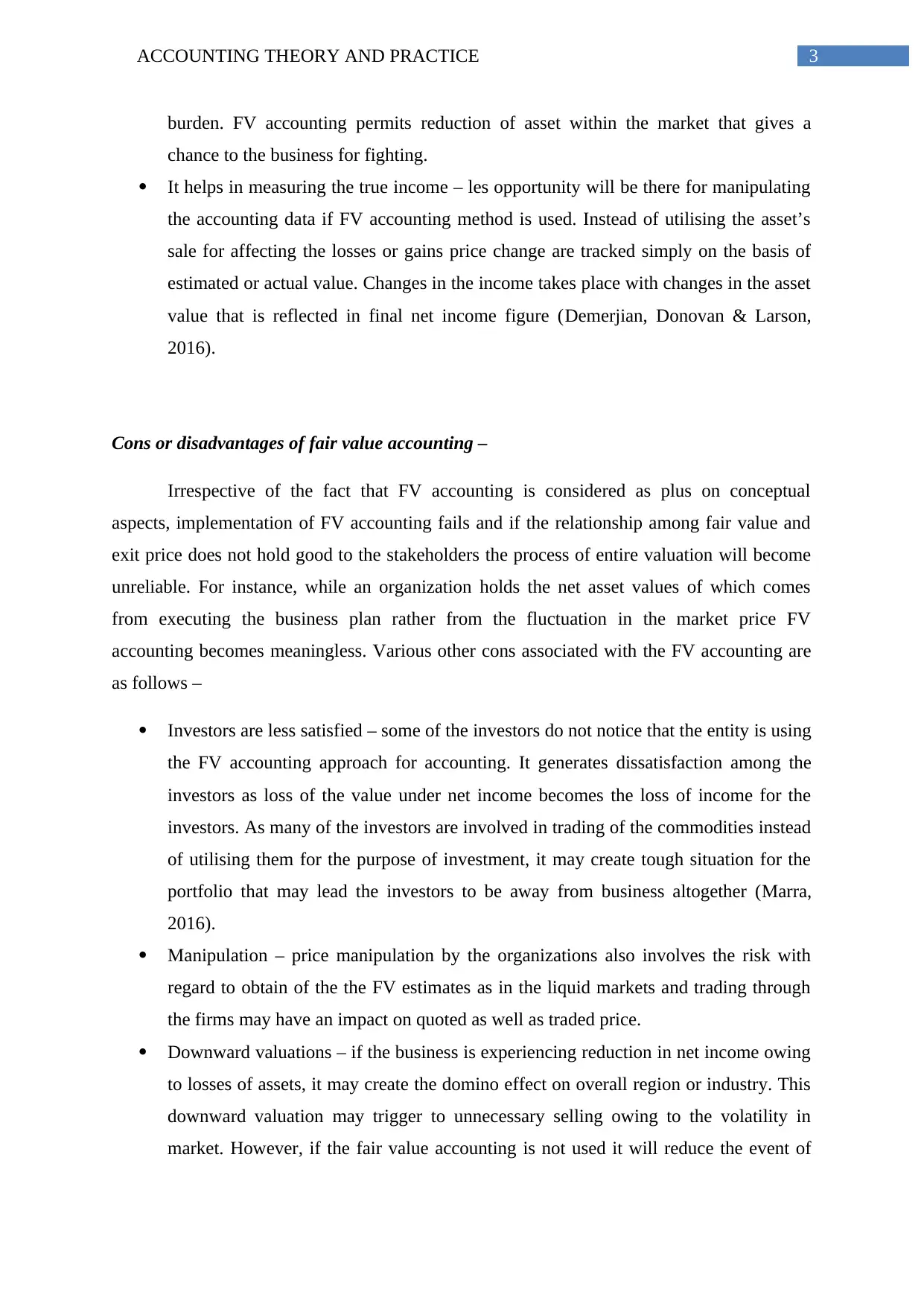
3ACCOUNTING THEORY AND PRACTICE
burden. FV accounting permits reduction of asset within the market that gives a
chance to the business for fighting.
It helps in measuring the true income – les opportunity will be there for manipulating
the accounting data if FV accounting method is used. Instead of utilising the asset’s
sale for affecting the losses or gains price change are tracked simply on the basis of
estimated or actual value. Changes in the income takes place with changes in the asset
value that is reflected in final net income figure (Demerjian, Donovan & Larson,
2016).
Cons or disadvantages of fair value accounting –
Irrespective of the fact that FV accounting is considered as plus on conceptual
aspects, implementation of FV accounting fails and if the relationship among fair value and
exit price does not hold good to the stakeholders the process of entire valuation will become
unreliable. For instance, while an organization holds the net asset values of which comes
from executing the business plan rather from the fluctuation in the market price FV
accounting becomes meaningless. Various other cons associated with the FV accounting are
as follows –
Investors are less satisfied – some of the investors do not notice that the entity is using
the FV accounting approach for accounting. It generates dissatisfaction among the
investors as loss of the value under net income becomes the loss of income for the
investors. As many of the investors are involved in trading of the commodities instead
of utilising them for the purpose of investment, it may create tough situation for the
portfolio that may lead the investors to be away from business altogether (Marra,
2016).
Manipulation – price manipulation by the organizations also involves the risk with
regard to obtain of the the FV estimates as in the liquid markets and trading through
the firms may have an impact on quoted as well as traded price.
Downward valuations – if the business is experiencing reduction in net income owing
to losses of assets, it may create the domino effect on overall region or industry. This
downward valuation may trigger to unnecessary selling owing to the volatility in
market. However, if the fair value accounting is not used it will reduce the event of
burden. FV accounting permits reduction of asset within the market that gives a
chance to the business for fighting.
It helps in measuring the true income – les opportunity will be there for manipulating
the accounting data if FV accounting method is used. Instead of utilising the asset’s
sale for affecting the losses or gains price change are tracked simply on the basis of
estimated or actual value. Changes in the income takes place with changes in the asset
value that is reflected in final net income figure (Demerjian, Donovan & Larson,
2016).
Cons or disadvantages of fair value accounting –
Irrespective of the fact that FV accounting is considered as plus on conceptual
aspects, implementation of FV accounting fails and if the relationship among fair value and
exit price does not hold good to the stakeholders the process of entire valuation will become
unreliable. For instance, while an organization holds the net asset values of which comes
from executing the business plan rather from the fluctuation in the market price FV
accounting becomes meaningless. Various other cons associated with the FV accounting are
as follows –
Investors are less satisfied – some of the investors do not notice that the entity is using
the FV accounting approach for accounting. It generates dissatisfaction among the
investors as loss of the value under net income becomes the loss of income for the
investors. As many of the investors are involved in trading of the commodities instead
of utilising them for the purpose of investment, it may create tough situation for the
portfolio that may lead the investors to be away from business altogether (Marra,
2016).
Manipulation – price manipulation by the organizations also involves the risk with
regard to obtain of the the FV estimates as in the liquid markets and trading through
the firms may have an impact on quoted as well as traded price.
Downward valuations – if the business is experiencing reduction in net income owing
to losses of assets, it may create the domino effect on overall region or industry. This
downward valuation may trigger to unnecessary selling owing to the volatility in
market. However, if the fair value accounting is not used it will reduce the event of
Paraphrase This Document
Need a fresh take? Get an instant paraphrase of this document with our AI Paraphraser
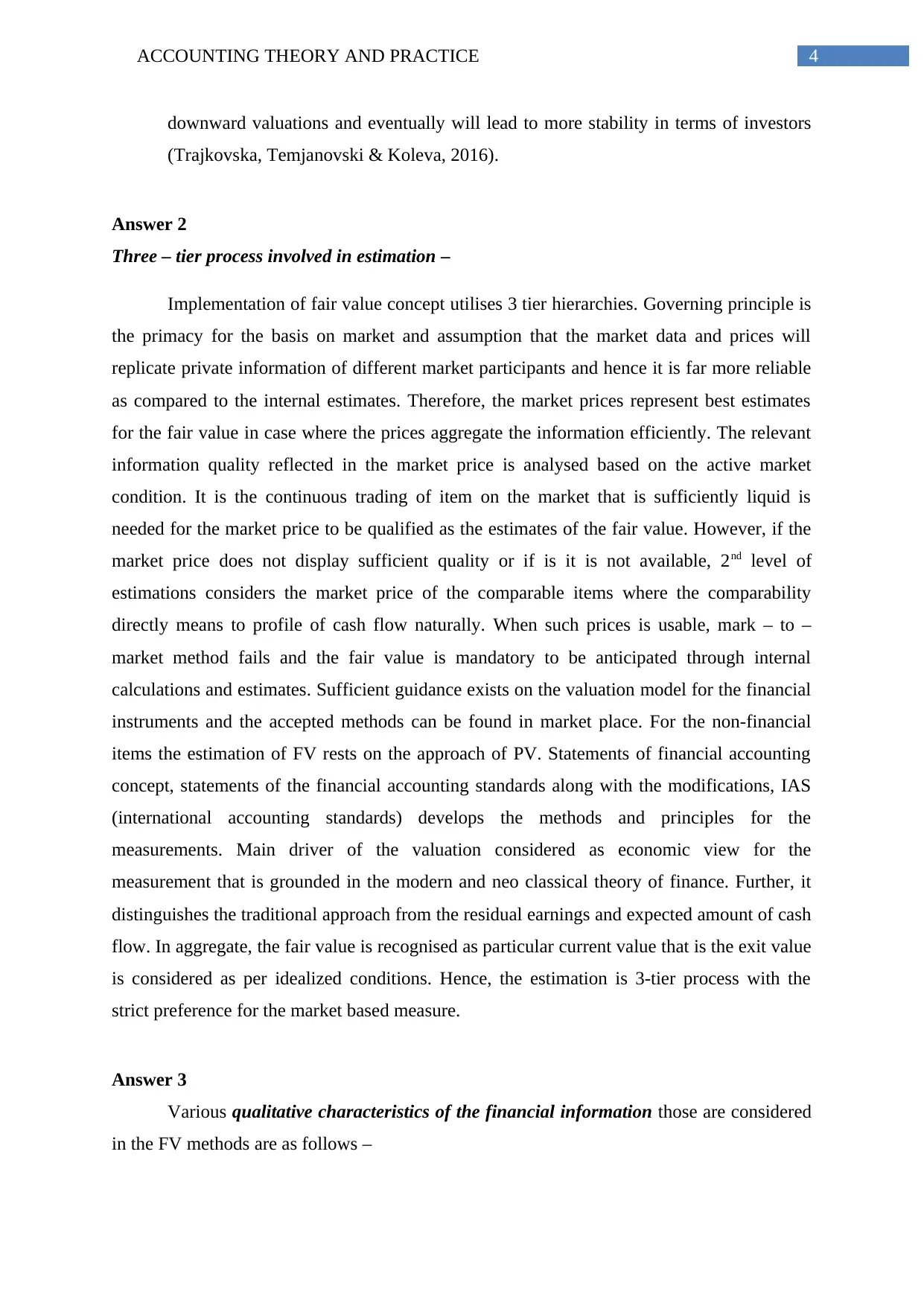
4ACCOUNTING THEORY AND PRACTICE
downward valuations and eventually will lead to more stability in terms of investors
(Trajkovska, Temjanovski & Koleva, 2016).
Answer 2
Three – tier process involved in estimation –
Implementation of fair value concept utilises 3 tier hierarchies. Governing principle is
the primacy for the basis on market and assumption that the market data and prices will
replicate private information of different market participants and hence it is far more reliable
as compared to the internal estimates. Therefore, the market prices represent best estimates
for the fair value in case where the prices aggregate the information efficiently. The relevant
information quality reflected in the market price is analysed based on the active market
condition. It is the continuous trading of item on the market that is sufficiently liquid is
needed for the market price to be qualified as the estimates of the fair value. However, if the
market price does not display sufficient quality or if is it is not available, 2nd level of
estimations considers the market price of the comparable items where the comparability
directly means to profile of cash flow naturally. When such prices is usable, mark – to –
market method fails and the fair value is mandatory to be anticipated through internal
calculations and estimates. Sufficient guidance exists on the valuation model for the financial
instruments and the accepted methods can be found in market place. For the non-financial
items the estimation of FV rests on the approach of PV. Statements of financial accounting
concept, statements of the financial accounting standards along with the modifications, IAS
(international accounting standards) develops the methods and principles for the
measurements. Main driver of the valuation considered as economic view for the
measurement that is grounded in the modern and neo classical theory of finance. Further, it
distinguishes the traditional approach from the residual earnings and expected amount of cash
flow. In aggregate, the fair value is recognised as particular current value that is the exit value
is considered as per idealized conditions. Hence, the estimation is 3-tier process with the
strict preference for the market based measure.
Answer 3
Various qualitative characteristics of the financial information those are considered
in the FV methods are as follows –
downward valuations and eventually will lead to more stability in terms of investors
(Trajkovska, Temjanovski & Koleva, 2016).
Answer 2
Three – tier process involved in estimation –
Implementation of fair value concept utilises 3 tier hierarchies. Governing principle is
the primacy for the basis on market and assumption that the market data and prices will
replicate private information of different market participants and hence it is far more reliable
as compared to the internal estimates. Therefore, the market prices represent best estimates
for the fair value in case where the prices aggregate the information efficiently. The relevant
information quality reflected in the market price is analysed based on the active market
condition. It is the continuous trading of item on the market that is sufficiently liquid is
needed for the market price to be qualified as the estimates of the fair value. However, if the
market price does not display sufficient quality or if is it is not available, 2nd level of
estimations considers the market price of the comparable items where the comparability
directly means to profile of cash flow naturally. When such prices is usable, mark – to –
market method fails and the fair value is mandatory to be anticipated through internal
calculations and estimates. Sufficient guidance exists on the valuation model for the financial
instruments and the accepted methods can be found in market place. For the non-financial
items the estimation of FV rests on the approach of PV. Statements of financial accounting
concept, statements of the financial accounting standards along with the modifications, IAS
(international accounting standards) develops the methods and principles for the
measurements. Main driver of the valuation considered as economic view for the
measurement that is grounded in the modern and neo classical theory of finance. Further, it
distinguishes the traditional approach from the residual earnings and expected amount of cash
flow. In aggregate, the fair value is recognised as particular current value that is the exit value
is considered as per idealized conditions. Hence, the estimation is 3-tier process with the
strict preference for the market based measure.
Answer 3
Various qualitative characteristics of the financial information those are considered
in the FV methods are as follows –
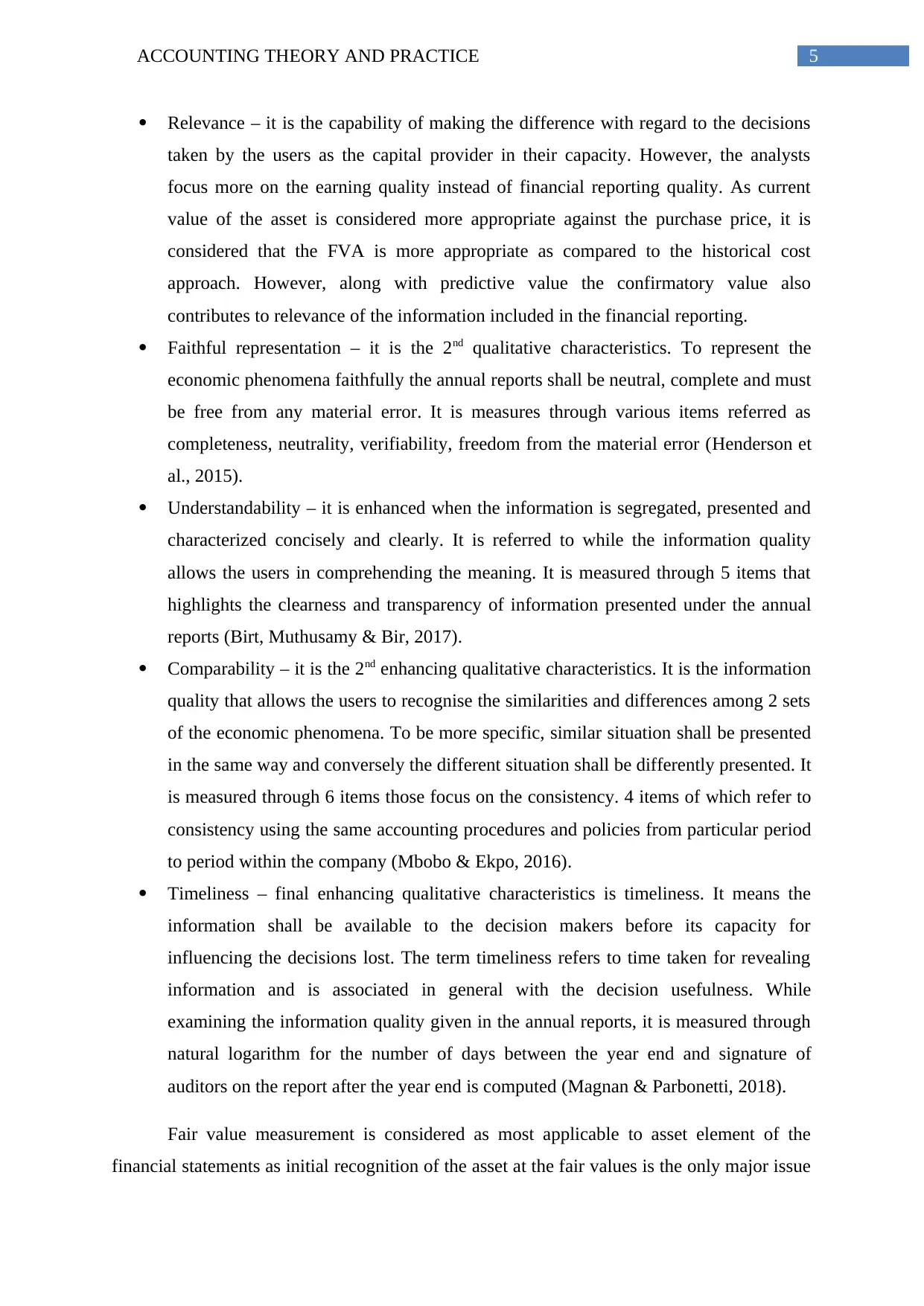
5ACCOUNTING THEORY AND PRACTICE
Relevance – it is the capability of making the difference with regard to the decisions
taken by the users as the capital provider in their capacity. However, the analysts
focus more on the earning quality instead of financial reporting quality. As current
value of the asset is considered more appropriate against the purchase price, it is
considered that the FVA is more appropriate as compared to the historical cost
approach. However, along with predictive value the confirmatory value also
contributes to relevance of the information included in the financial reporting.
Faithful representation – it is the 2nd qualitative characteristics. To represent the
economic phenomena faithfully the annual reports shall be neutral, complete and must
be free from any material error. It is measures through various items referred as
completeness, neutrality, verifiability, freedom from the material error (Henderson et
al., 2015).
Understandability – it is enhanced when the information is segregated, presented and
characterized concisely and clearly. It is referred to while the information quality
allows the users in comprehending the meaning. It is measured through 5 items that
highlights the clearness and transparency of information presented under the annual
reports (Birt, Muthusamy & Bir, 2017).
Comparability – it is the 2nd enhancing qualitative characteristics. It is the information
quality that allows the users to recognise the similarities and differences among 2 sets
of the economic phenomena. To be more specific, similar situation shall be presented
in the same way and conversely the different situation shall be differently presented. It
is measured through 6 items those focus on the consistency. 4 items of which refer to
consistency using the same accounting procedures and policies from particular period
to period within the company (Mbobo & Ekpo, 2016).
Timeliness – final enhancing qualitative characteristics is timeliness. It means the
information shall be available to the decision makers before its capacity for
influencing the decisions lost. The term timeliness refers to time taken for revealing
information and is associated in general with the decision usefulness. While
examining the information quality given in the annual reports, it is measured through
natural logarithm for the number of days between the year end and signature of
auditors on the report after the year end is computed (Magnan & Parbonetti, 2018).
Fair value measurement is considered as most applicable to asset element of the
financial statements as initial recognition of the asset at the fair values is the only major issue
Relevance – it is the capability of making the difference with regard to the decisions
taken by the users as the capital provider in their capacity. However, the analysts
focus more on the earning quality instead of financial reporting quality. As current
value of the asset is considered more appropriate against the purchase price, it is
considered that the FVA is more appropriate as compared to the historical cost
approach. However, along with predictive value the confirmatory value also
contributes to relevance of the information included in the financial reporting.
Faithful representation – it is the 2nd qualitative characteristics. To represent the
economic phenomena faithfully the annual reports shall be neutral, complete and must
be free from any material error. It is measures through various items referred as
completeness, neutrality, verifiability, freedom from the material error (Henderson et
al., 2015).
Understandability – it is enhanced when the information is segregated, presented and
characterized concisely and clearly. It is referred to while the information quality
allows the users in comprehending the meaning. It is measured through 5 items that
highlights the clearness and transparency of information presented under the annual
reports (Birt, Muthusamy & Bir, 2017).
Comparability – it is the 2nd enhancing qualitative characteristics. It is the information
quality that allows the users to recognise the similarities and differences among 2 sets
of the economic phenomena. To be more specific, similar situation shall be presented
in the same way and conversely the different situation shall be differently presented. It
is measured through 6 items those focus on the consistency. 4 items of which refer to
consistency using the same accounting procedures and policies from particular period
to period within the company (Mbobo & Ekpo, 2016).
Timeliness – final enhancing qualitative characteristics is timeliness. It means the
information shall be available to the decision makers before its capacity for
influencing the decisions lost. The term timeliness refers to time taken for revealing
information and is associated in general with the decision usefulness. While
examining the information quality given in the annual reports, it is measured through
natural logarithm for the number of days between the year end and signature of
auditors on the report after the year end is computed (Magnan & Parbonetti, 2018).
Fair value measurement is considered as most applicable to asset element of the
financial statements as initial recognition of the asset at the fair values is the only major issue
⊘ This is a preview!⊘
Do you want full access?
Subscribe today to unlock all pages.

Trusted by 1+ million students worldwide
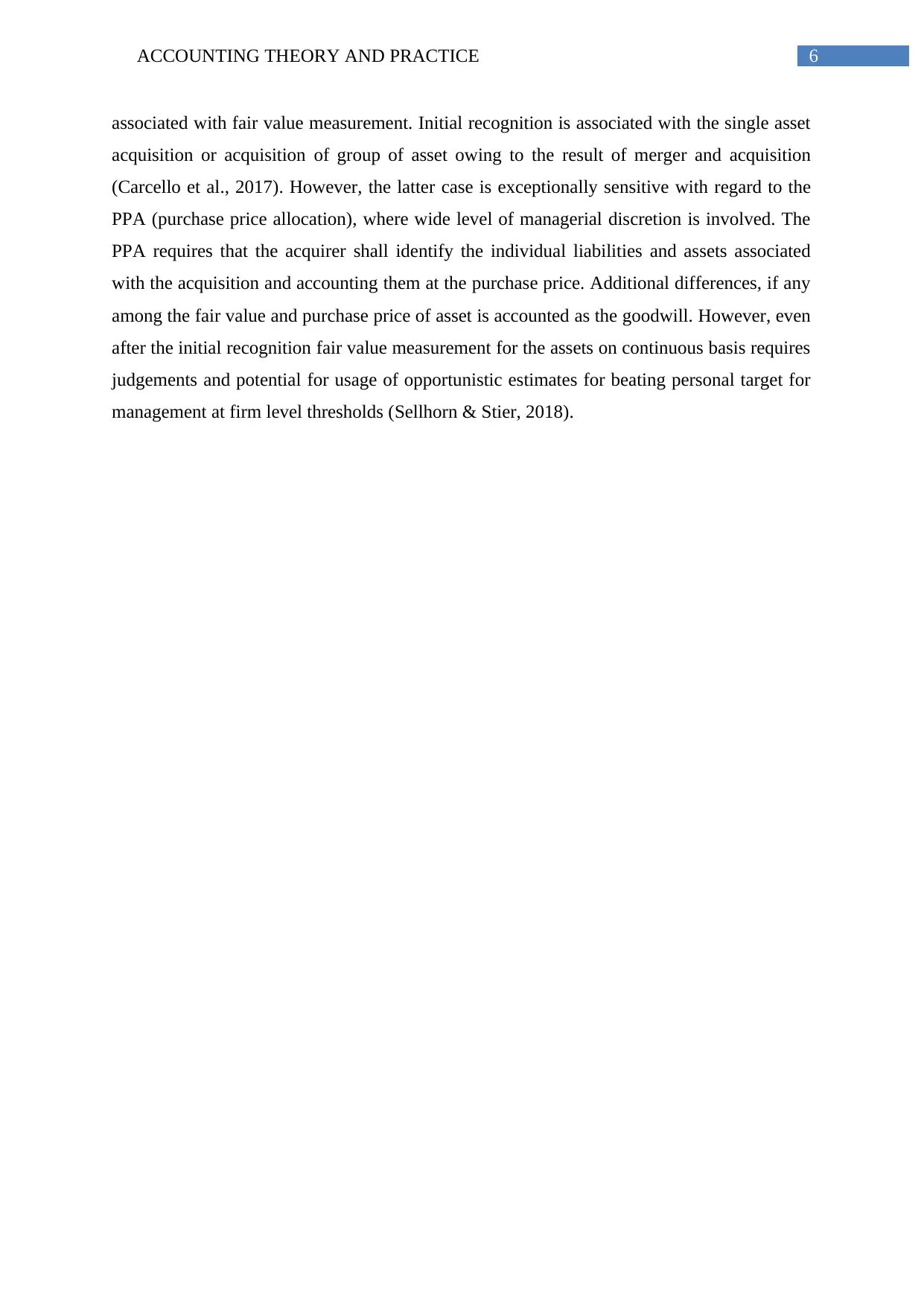
6ACCOUNTING THEORY AND PRACTICE
associated with fair value measurement. Initial recognition is associated with the single asset
acquisition or acquisition of group of asset owing to the result of merger and acquisition
(Carcello et al., 2017). However, the latter case is exceptionally sensitive with regard to the
PPA (purchase price allocation), where wide level of managerial discretion is involved. The
PPA requires that the acquirer shall identify the individual liabilities and assets associated
with the acquisition and accounting them at the purchase price. Additional differences, if any
among the fair value and purchase price of asset is accounted as the goodwill. However, even
after the initial recognition fair value measurement for the assets on continuous basis requires
judgements and potential for usage of opportunistic estimates for beating personal target for
management at firm level thresholds (Sellhorn & Stier, 2018).
associated with fair value measurement. Initial recognition is associated with the single asset
acquisition or acquisition of group of asset owing to the result of merger and acquisition
(Carcello et al., 2017). However, the latter case is exceptionally sensitive with regard to the
PPA (purchase price allocation), where wide level of managerial discretion is involved. The
PPA requires that the acquirer shall identify the individual liabilities and assets associated
with the acquisition and accounting them at the purchase price. Additional differences, if any
among the fair value and purchase price of asset is accounted as the goodwill. However, even
after the initial recognition fair value measurement for the assets on continuous basis requires
judgements and potential for usage of opportunistic estimates for beating personal target for
management at firm level thresholds (Sellhorn & Stier, 2018).
Paraphrase This Document
Need a fresh take? Get an instant paraphrase of this document with our AI Paraphraser
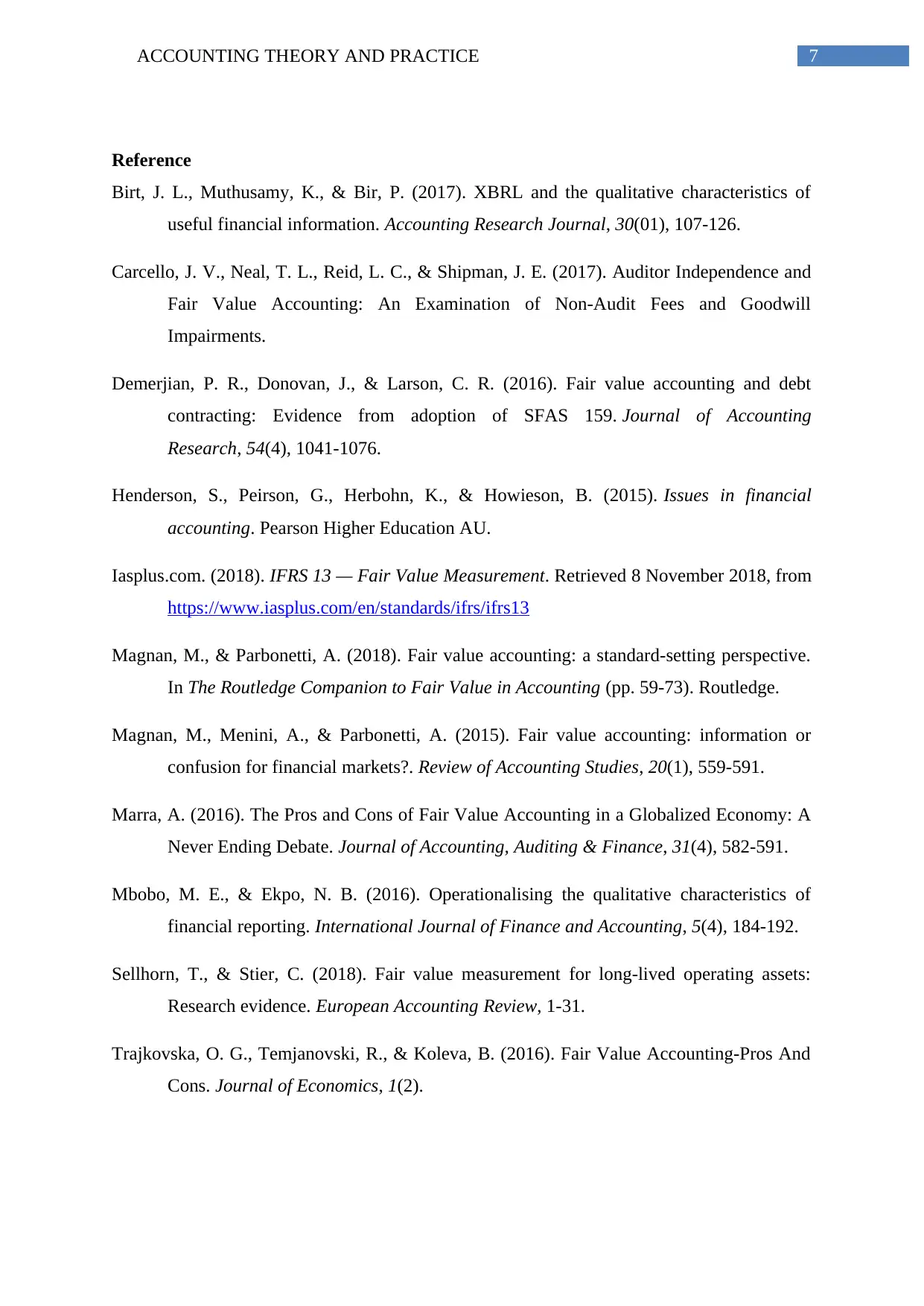
7ACCOUNTING THEORY AND PRACTICE
Reference
Birt, J. L., Muthusamy, K., & Bir, P. (2017). XBRL and the qualitative characteristics of
useful financial information. Accounting Research Journal, 30(01), 107-126.
Carcello, J. V., Neal, T. L., Reid, L. C., & Shipman, J. E. (2017). Auditor Independence and
Fair Value Accounting: An Examination of Non-Audit Fees and Goodwill
Impairments.
Demerjian, P. R., Donovan, J., & Larson, C. R. (2016). Fair value accounting and debt
contracting: Evidence from adoption of SFAS 159. Journal of Accounting
Research, 54(4), 1041-1076.
Henderson, S., Peirson, G., Herbohn, K., & Howieson, B. (2015). Issues in financial
accounting. Pearson Higher Education AU.
Iasplus.com. (2018). IFRS 13 — Fair Value Measurement. Retrieved 8 November 2018, from
https://www.iasplus.com/en/standards/ifrs/ifrs13
Magnan, M., & Parbonetti, A. (2018). Fair value accounting: a standard-setting perspective.
In The Routledge Companion to Fair Value in Accounting (pp. 59-73). Routledge.
Magnan, M., Menini, A., & Parbonetti, A. (2015). Fair value accounting: information or
confusion for financial markets?. Review of Accounting Studies, 20(1), 559-591.
Marra, A. (2016). The Pros and Cons of Fair Value Accounting in a Globalized Economy: A
Never Ending Debate. Journal of Accounting, Auditing & Finance, 31(4), 582-591.
Mbobo, M. E., & Ekpo, N. B. (2016). Operationalising the qualitative characteristics of
financial reporting. International Journal of Finance and Accounting, 5(4), 184-192.
Sellhorn, T., & Stier, C. (2018). Fair value measurement for long-lived operating assets:
Research evidence. European Accounting Review, 1-31.
Trajkovska, O. G., Temjanovski, R., & Koleva, B. (2016). Fair Value Accounting-Pros And
Cons. Journal of Economics, 1(2).
Reference
Birt, J. L., Muthusamy, K., & Bir, P. (2017). XBRL and the qualitative characteristics of
useful financial information. Accounting Research Journal, 30(01), 107-126.
Carcello, J. V., Neal, T. L., Reid, L. C., & Shipman, J. E. (2017). Auditor Independence and
Fair Value Accounting: An Examination of Non-Audit Fees and Goodwill
Impairments.
Demerjian, P. R., Donovan, J., & Larson, C. R. (2016). Fair value accounting and debt
contracting: Evidence from adoption of SFAS 159. Journal of Accounting
Research, 54(4), 1041-1076.
Henderson, S., Peirson, G., Herbohn, K., & Howieson, B. (2015). Issues in financial
accounting. Pearson Higher Education AU.
Iasplus.com. (2018). IFRS 13 — Fair Value Measurement. Retrieved 8 November 2018, from
https://www.iasplus.com/en/standards/ifrs/ifrs13
Magnan, M., & Parbonetti, A. (2018). Fair value accounting: a standard-setting perspective.
In The Routledge Companion to Fair Value in Accounting (pp. 59-73). Routledge.
Magnan, M., Menini, A., & Parbonetti, A. (2015). Fair value accounting: information or
confusion for financial markets?. Review of Accounting Studies, 20(1), 559-591.
Marra, A. (2016). The Pros and Cons of Fair Value Accounting in a Globalized Economy: A
Never Ending Debate. Journal of Accounting, Auditing & Finance, 31(4), 582-591.
Mbobo, M. E., & Ekpo, N. B. (2016). Operationalising the qualitative characteristics of
financial reporting. International Journal of Finance and Accounting, 5(4), 184-192.
Sellhorn, T., & Stier, C. (2018). Fair value measurement for long-lived operating assets:
Research evidence. European Accounting Review, 1-31.
Trajkovska, O. G., Temjanovski, R., & Koleva, B. (2016). Fair Value Accounting-Pros And
Cons. Journal of Economics, 1(2).

8ACCOUNTING THEORY AND PRACTICE
⊘ This is a preview!⊘
Do you want full access?
Subscribe today to unlock all pages.

Trusted by 1+ million students worldwide
1 out of 9
Related Documents
Your All-in-One AI-Powered Toolkit for Academic Success.
+13062052269
info@desklib.com
Available 24*7 on WhatsApp / Email
![[object Object]](/_next/static/media/star-bottom.7253800d.svg)
Unlock your academic potential
Copyright © 2020–2025 A2Z Services. All Rights Reserved. Developed and managed by ZUCOL.



